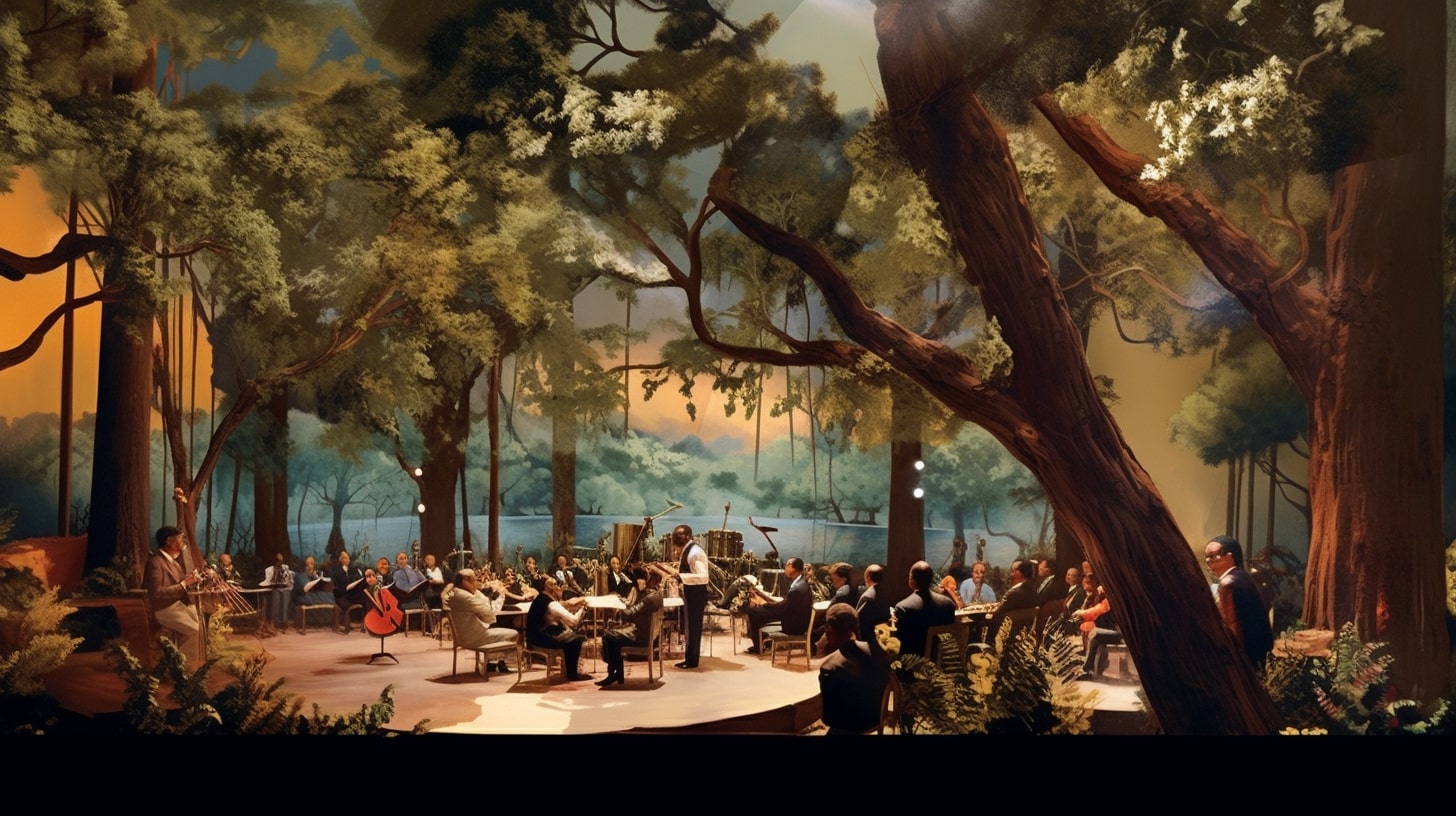Charlie Parker, an American alto saxophonist, composer, and bandleader, was a paramount figure in the world of jazz. Known by the nicknames Bird and Yardbird, Parker was often regarded as the greatest jazz saxophonist in the music genre’s history.
Parker’s innovative approach using his chosen instrument pushed the boundaries of what was considered possible in jazz. His techniques and distinctive sound continue influencing contemporary musicians, solidifying his place as a true musical icon.
Contents
Charlie Parker and the Alto Saxophone
Early Life and Influences
Charlie Parker was born on August 29, 1920, in Kansas City, Kansas. He grew up in a musical environment, with his mother giving him a saxophone when he was just a teenager. At the age of 15, Parker chose the alto saxophone as his primary instrument.
He was heavily influenced by the Kansas City jazz scene, which was thriving during his formative years. Parker first gained experience playing in local nightclubs and eventually joined the Jay McShann Orchestra, a popular Kansas City-based band.
Development of Bebop Style
As a highly influential jazz saxophonist, Parker played a significant role in the development of bebop. Bebop, characterized by fast tempos, advanced harmonies, and virtuosic technique, was a departure from the more structured and orchestrated big band sound of the time. Instead, bebop allowed musicians to showcase their improvisational skills and individuality.
Parker’s innovative playing style on the alto saxophone helped shape the bebop movement. He was known for his exceptional technique, unique phrasing, and innovative harmonic approach, all of which contributed to the rapid evolution of jazz during the mid-twentieth century.
Collaborations and Notable Musicians
Dizzy Gillespie and Thelonious Monk
Charlie Parker, an American jazz saxophonist known as “Bird” or “Yardbird,” often collaborated with Dizzy Gillespie, a trumpeter, and pianist. Together, they played a crucial role in the development of bebop, a form of jazz characterized by fast tempos, virtuosic technique, and advanced harmonies. They first began playing together in the early 1940s, and their mutual influence on each other’s music continued throughout their careers.
Parker also worked with Thelonious Monk, a highly influential pianist and composer. Their collaborations included performances at the Birdland jazz club, named after Charlie Parker himself. These sessions showcased their unique styles and further solidified Parker’s status as a groundbreaking jazz musician.
Miles Davis and the Davis-Parker Quintet
Miles Davis, a legendary trumpeter, joined forces with Charlie Parker in the mid-1940s, with the two forming a quintet known as the Davis-Parker Quintet. Their collaboration resulted in numerous recordings that showcased Parker’s virtuosic alto sax skills and Davis’ innovative trumpet playing.
At the time, the bebop style they popularized was considered revolutionary. It led to a new era of jazz that influenced countless musicians, including Louis Armstrong, who began incorporating bebop elements into his own music. The Davis-Parker Quintet played a crucial role in shaping the direction of jazz for years to come.
While Charlie Parker collaborated with many notable musicians, it is his work with Dizzy Gillespie, Thelonious Monk, and Miles Davis that remains the most significant in terms of his contributions to jazz history. These collaborations set the stage for the fusion of styles, techniques, and improvisational approaches that continue to define and influence jazz music today.
Parker’s Work and Impact on Jazz
Influential Albums and Tracks
Charlie Parker, also known as Bird or Yardbird, was an American jazz saxophonist, bandleader, and composer who played the alto saxophone. He was a leading figure in the development of bebop, a form of jazz characterized by fast tempos, virtuosic technique, and advanced harmonies. Some of his most influential albums and tracks include:
- Ornithology: A bebop standard, Ornithology showcases Parker’s ability to create melodies based on chord progressions of existing tunes.
- Yardbird Suite: Composed by Parker, this piece is a great example of his mature bebop style and has become a jazz standard.
- Cool Blues: This blues-based composition showcases Parker’s rhythmic and melodic innovation and his improvisational skills.
- Jazz at Massey Hall: A live concert recording featuring Parker along with other bebop legends like Dizzy Gillespie, Bud Powell, Charles Mingus, and Max Roach.
Bird’s Legendary Solos
Throughout his career, Charlie Parker revolutionized jazz music with his unique improvisational style and technique, which can be heard clearly in his legendary solos. A few examples include:
- Ko-Ko: In this recording from 1945, Parker demonstrates his bebop mastery by applying innovative phrasing and complex harmonies while playing an effortlessly fast tempo.
- Donna Lee: Parker’s solo on this piece, composed by Miles Davis, features a highly complex and technically demanding melody that was unprecedented at the time.
- Now’s the Time: Known for his blues-based compositions, Parker’s solo on this more relaxed tempo piece showcases his ability to integrate bebop concepts within the blues framework.
Charlie Parker’s contributions to the world of jazz were vast, earning him a lasting reputation as one of the great jazz musicians of all time. His innovative techniques and compositions continue to profoundly influence modern jazz, with generations of musicians carrying on his legacy.
Personal Life and Struggles
Relationships and Family
Charlie Parker was an American jazz saxophonist who played the alto saxophone. Born in Kansas City, Missouri, Parker was drawn to music from a young age, playing the baritone horn before switching to the alto saxophone. In his personal life, he had multiple relationships and was married several times.
One of his most notable relationships was with Chan Parker, who would later write a memoir about their life together. Charlie Parker had children from his various relationships, and some of his descendants have continued his musical legacy.
Substance Abuse and Mental Health Issues
Unfortunately, Charlie Parker’s life was marred by substance abuse and mental health issues. He struggled with heroin addiction and alcoholism throughout his career. The use of heroin was common among many jazz musicians during this time period, and Parker was no exception. His addiction led to numerous personal and professional challenges, such as missed performances, financial hardship, and deteriorating health.
In addition to his struggles with addiction, Parker also faced mental health issues. It’s unclear if these problems were a result of his substance abuse or if they existed prior to his addiction, but they undoubtedly had a significant impact on his life and career. Despite these difficulties, Charlie Parker created extraordinary music and contributed significantly to the development of bebop and modern jazz.
Legacy and Untimely Death
Tributes and Posthumous Releases
Charlie Parker passed away on March 12, 1955, due to a heart attack, at the age of 34. Parker’s untimely death shook the jazz community, and numerous tributes and posthumous releases emerged to honor his legacy. One notable tribute is the famous jazz venue Birdland Club, named in his honor.
Throughout the years, several previously unreleased recordings of Parker’s music have been issued, allowing his work to remain a vital part of the jazz landscape. Other artists, such as drummer Kenny Clarke, have paid homage to Parker by citing him as an inspiration in their own work.
Influence on Future Generations
Charlie Parker’s impact on jazz is indisputable. He, along with other musicians like Kenny Clarke, helped to develop bebop, characterized by fast tempos, virtuosic technique, and advanced harmonies. Parker’s innovative approach to the alto saxophone revolutionized the genre and influenced countless musicians who came after him, not just within jazz but across various musical styles.
The extent of his influence also spread to Europe, where aspiring jazz musicians eagerly studied his recordings and sought to emulate his groundbreaking techniques. Even today, decades after his passing, Charlie Parker remains an essential figure in the world of music, and his contributions to jazz continue to inspire new generations of artists.






